Our door pull-up bar is as practical as can be: simply hook it into the door, and you'll start your own home gym with ease. With the pull-up bar door exercises, you use your own body weight to train your muscles.
In the video below, you can see almost all of the top 15 pull-up bar door exercises presented and explained in this blog post. The majority of the exercises are pulling exercises that mainly challenge the back muscles, the anterior upper arm muscles around the biceps and the forearm muscles. We also present some exercises for the abdominal muscles. In the scope of delivery of our pull-up bar you will also find a strap, which makes training easier for beginners, because it supports the execution of the exercise.
Our pull-up bar can also be used beyond the door: by placing it on the floor, it serves as equipment for a range of chest and triceps exercises. With that in mind, although it's called a pull-up bar, it's much more than that. It's your mobile and small gym, which you can supplement with useful additional equipment like resistance bands and calisthenics rings.
Enough of the preface: want to get your muscles burning? Then let's get started with our top 15 pull-up bar door exercises that can be performed not only on the pull-up bar, but also on the wall, Pullup & Dip bar, in the calisthenics park, and on outdoor bars!
Introductory notes to the exercises
The following tips serve as basics that you should keep in mind when performing the exercises in order to ensure an efficient and safe workout:
- Always keep the tension! In most cases, your body must form as straight a line as possible during the exercises, which you can only ensure through tension in the relevant parts of the body. Through the tension you also train far more muscles than intended in the exercises.
- Exercise strength in a concentrated way! We will explain which muscles are trained in each of the following pull-up bar door exercises. Concentrate on these muscles during the workout, so that you can specifically exert the strength from them and increase the training effect.
- Breathing must be learned! Breathe in during the relaxation phase and out during the load phase. When you pull yourself up in pull-ups or lift your legs in abdominal exercises, you should exhale, because it is the load phase in which you are pushing resistance.
- Control the speed! You perform the exercises in a controlled manner if you never sink completely in the relaxation phase, but make a slow downward movement. This may last 2 seconds, while the upward movement should be quite explosive.
#1 Pull-ups

Pullups are the mother of all back exercises. If bodybuilding didn't have deadlifts as one of three basic exercises, pullups would probably take this role, because hardly any exercise is as efficient and demanding for the entire back musculature as pullups: Especially the large and small teres muscle as well as the large and small rhomboid muscle are stressed. The upper arm and forearm muscles are also challenged.
The wide range of muscles trained makes pull-ups among the pull-up bar door exercises a must-have of your own weight training. To make sure that you do everything right, stay away from injuries and achieve fast muscle gains, it's best to follow the instructions on how to perform the exercise.
- Grasp the pull-up bar with both hands in an overhand grip - i.e., with the backs of the hands facing you. The hands are shoulder-width apart.
- Pull yourself up. Make sure you pull yourself up using the strength of your arms. Under no circumstances should you swing yourself upward.
- Once your chin is level with the pull-up bar, slowly lower yourself down in a controlled manner.
#2 Hammer Grip Pull-ups

Hammer grip pull-ups are also called neutral grip pull-ups. With both names, the name tells you how to grip the pull-up bar. A good product like our door pull-up bar includes handles that point in your direction in addition to the bar running to the side. When you grab these handles, your palms are neither facing you (overgrip) nor away from you (undergrip), but are neutral: the palms are facing each other and it's like you're holding a hammer. That's how the names of these pull-up bar door exercises come about. But enough of onomatology (which, by the way, is "name research" that you can brag about to others while training) ?!
What's important for you is the benefit of the exercise. Apart from the fact that Hammer Grip Pull-ups are a welcome change from other pull-up bar door exercises and make your workout more varied, you set new priorities in training your muscles: You'll challenge your upper arm muscles more than with other pull-up variations - the biceps, brachialis and brachioradialis muscles to be exact. The execution is identical to that of normal pull-ups except for the grip position of the hands.
[product="P-01010"]
#3 Chin-ups

Chin-ups are sometimes called the most complete of the pull-up bar door exercises because they involve the upper arm and forearm muscles more in the workout than the other pull-up variations. Nevertheless, because the upper back muscles remain on board and you achieve a greater range of motion during exercise execution than with other pull-up variations for anatomical reasons, the back is also trained incredibly efficiently.
Sounds a bit complicated? No problem, the following instructions will help you in the best possible way:
- Grasp the pull-up bar with both hands in an underhand grip so that the palms are facing you. The hands are shoulder-width apart.
- Pull yourself up as you did with the pull-ups. But be careful: Because of the underhand grip, you will come up much further. Ideally, you should pull your chin up a few inches further than the height of the pull-up bar in order to have more range of motion in the exercise.
- Once your upper arms are parallel to your torso in the up position, slowly move down in a controlled manner.
Range of motion is an important indicator of the intensity of your workout. It is important to note that the range of motion should be used in such a way that it does not exceed the anatomically healthy limits of the body. For a "healthy range of motion" in the top position, make sure that your upper arms are not simply parallel to your torso, but that they are tight against your torso while doing so.
#4 Assisted Pull-ups with Band

Convenient: The band is included with our pull-up bar, so you can also perform pull-up bar door exercises with a band. This is especially beneficial for beginners, as assisted pull-ups absorb some of the body weight and make it easier to perform pull-ups. Those who, due to strength deficits, manage too few pull-ups for an adequate workout with, for example, 3 sets of 10 repetitions, can train with less effort thanks to the Assisted Pull-ups and get fit step by step for the pull-up bar door exercises without support.
So, the Assisted Pull-ups are a pullup variation that is performed like all other pullup variations and is only differentiated by the use of a band:
- You attach the band to a special handle in the middle of the pull-up bar.
- Pull it down against the resistance and stand with your feet in the middle of the band.
- Now you can hang on the pull-up bar and perform the desired pull-up variation, always supporting you with the upward pull of the band during the movement.
[product="P-00095"]
#5 Scapular Pull-ups

One of the most fascinating pull-up bar door exercises that is unfortunately still too little known: the Scapular Pull-ups. The long-term successful pull-up training requires healthy and strong shoulders. Basically, pull-ups do not train the shoulder muscles much, but if you do something wrong during the exercise, strong shoulder muscles can absorb faulty movements well and prevent injuries.
Scapular pull-ups are an exercise that you perform on the pull-up bar, where you specifically challenge the shoulder muscles. Thus, the Scapular Pull-ups contribute on the one hand to a strengthening of your shoulder muscles, promote on the other hand by strengthening the shoulders and the resulting injury prevention your other pull-up training and other pressure exercises. They are performed as follows:
- Hang from the pull-up bar as you would for the classic pull-ups – i.e., in an overhand grip. Your hands are positioned shoulder-width apart.
- Press your shoulder blades – and really only the shoulder blades – up and down. The movement of your shoulder blades will cause your chest to move up and down; your upper and lower arms will rotate minimally in and out.
- Hold the up position for a second and then slowly move downward, then restart the upward movement by pushing upward from your shoulder blades.
Although this exercise is christened pull-ups, unlike the previous pull-up bar door exercises, you are hardly making any significant movement with your body upwards. Since you're specifically moving your shoulder blades up, the movement is minimal – anything else would be an indication of improper exercise execution. Helpful when performing them: imagine you're trying to bend the barbell with your hands – that's how the pushing motion occurs, propelling your shoulder blades upward.
#6 Knee Raises

This exercise challenges your upper arm and neck muscles, as well as minimally the muscles of your upper back, due to your position on the incline. However, the focus is on training your abdominal muscles:
- While hanging, bend your knees so that your upper and lower legs are at a 90-degree angle to each other.
- Then move your legs up in this position parallel to each other; for example, to the point where your knees almost touch your chin.
- The range of motion is less important than the fact that you are working specifically from the strength of your abdominal muscles. Move your knees at least just above chest level.
You should never pull your torso up, combining pull-ups with knee raises. Hang in front of you – but don't let yourself sag completely – and focus entirely on your abdominal muscles. In this exercise in particular, without ample concentration, you'll miss the abs and be more prone to "flinging" yourself up from the strength of your legs.
#7 Leg Raises

An alternative to the Knee Raises is the Leg Raises (in German: Beinheben). The muscle groups trained are similar to those used in knee raises; with the difference that the lower abdominal muscles are more involved. Especially the effective training of the lower abdominal muscles is an enormous challenge among strength athletes and in self-weight training. During dieting phases, many an athlete despairs of achieving a clearly visible six-pack or even eight-pack. Even though diet is the key to achieving a high level of definition, Leg Raises are a useful additional tool as one of our pull-up bar door exercises.
Differentiating from the Knee Raises, in this exercise you don't angle your legs, but leave them extended. Tighten the extended legs and move them parallel upwards. As soon as you extend your legs above hip height, the lower abdominal muscles are intensively trained. Ideally, you should reach the level of your head while doing leg raises.
Because the legs are fully extended, the load on the thigh muscles is much greater than with the Knee Raises. Thus, you can also consider the Leg Raises as a "soft leg workout". However, you should not expect a noticeable muscle gain in your thighs through this exercise.
#8 Toes to Bar

You perform this exercise the same way as the Leg Raises, but unlike the Leg Raises, you go above head height and move your fully extended legs with your toes up to the bar. Due to the higher range of motion, you work the hip-extending muscles more intensively than with the Leg Raises. In addition to the lower abdominal muscles, the upper abdominal muscles are more involved because the range of motion increases.
[product="P-01010"]
#9 Front Lever

The Front Lever is one of the few pull-up bar door exercises for the whole body that works all the muscles of the back, biceps, forearm muscles, abdominal muscles and shoulder muscles the most. To a lesser extent, you train the triceps, pectorals and leg muscles. Does the number of muscles trained sound promising? It sure does! Here's how this awesome exercise works:
- Hang on the pull-up bar with your hands in an overhand grip, just as you do with classic pull-ups.
- Now lift your legs and move your upper body backward, forming a straight line from your legs to your head.
- In the starting position of the Front Lever, you are positioned horizontally like the bar; you are virtually "lying" in the air. You hold this position for as long as possible or you repeat the exercise and hold the position for a certain period of time each time.
In order to maintain the horizontal position, you need to keep the muscles of your whole body tense at all times. This is the reason why the exercise works so many muscle groups – including even the chest and triceps muscles, which are not actually required in pulling exercises.
#10 Australian Pull-ups with rings

For Australian Pull-ups, you'll hang rings – similar to those used by gymnasts – from the pull-up bar. Pull-up bar door exercises with provide have the advantage that the rings take away stability and your muscles get a more intense workout because of the more difficult coordination and balance. In this respect, pull-up bar door exercises with rings come in handy to make exercises more intense.
As for the Australian Pull-ups, despite the more difficult balance, they are a beginner's exercise because you're training with your feet on the ground, neutralizing a significant portion of your body weight as a load. Nevertheless, it's worth your while to get to grips with the exercise even if you're more advanced, as the One Arm Australian Pull-ups with Rings are also explained as one of our other pull-up bar door exercises and already represent a significant tightening of the difficulty level. Now turn up your attention and learn how to perform the two-handed Australian Pull-ups:
- Attach the rings to the dumbbell bar so they hang down and are about waist high. You grab the rings at the level of your nipples.
- Now hang from the rings. Since they are so far down you need to place your feet on the ground and tense the rest of your body in order to not touch the floor with the rest of your body.
- Your body will be almost horizontal as you hang from the rings and begin to pull yourself up.
- You pull yourself up with your palms facing either out to the side or away from you frontally – so a neutral grip or an under grip. Bring your upper arms along your torso.
- In the top position, your nipples should be level with the handles. From this position, lower yourself down and repeat the exercise as many times as you like.
The muscle groups trained are the upper, lateral and lower back muscles, with the latter two being trained more than with pull-ups. In addition, in the Australian Pull-ups with rings also trains: The abdominal muscles, which together with the lower back muscles must be tensed during the execution of the exercise, as well as the upper and lower arm muscles.
#11 One Arm Australian Pull-ups with Rings

Among the One Arm Australian Pull-ups, there are several variations. The core idea of these pull-up bar door exercises of this type is always the same: you get into an identical starting position as in the two-handed Australian Pull-ups; the execution of these exercises is also identical with the exception that you pull yourself up with only one arm. Whether you do several repetitions with one arm first and then train the other or switch arms for each repetition is entirely up to you.
What you do with the free arm varies with the variation of the One Arm Australian Pull-ups: You can extend the free arm outward and thereby slightly train the shoulder and chest muscles as well. Likewise, you can simply let the free arm hang. The advantage of doing the exercise with one hand is that it puts more strain on the muscles. Your workout will be more efficient and challenging.
#12 Biceps Curls (with rings)

Biceps curls without a dumbbell: The rings in the pull-up bar door exercises make it possible! You attach them to the bar like you would for Australian Pull-ups and grab them. Then position yourself in a way that your feet are about level with the pull-up bar. Your entire body forms a straight line as you then hang backward with your upper body holding onto the rings. You pull yourself up from the hang position, bringing only your upper arms up to your forearms. This way, you'll work out of your biceps and primarily train the anterior muscles of your upper arms as well as your forearms.
The particular advantage of biceps curls with rings on the pull-up bar is the largely isolated biceps workout: although you can also target your biceps through the chin-ups, you can't isolate them nearly as well as you can with biceps curls with rings.
#13 Face Pulls (with rings)

The Face Pulls as one of our top 15 pull-up bar door exercises gives you the chance to train your neck muscles highly efficiently. You will also train your posterior shoulder muscles extremely effectively with this exercise. These muscles are the ones that are neglected or play a subordinate role in pull-ups and many other back training exercises.
So, with the Face Pulls you work on details of your visual appearance, which contributes to the aesthetics of your overall muscular appearance, and you gain benefits on a functional level, because the muscles you train work as supporting muscles in larger and more demanding pull-up bar door exercises.
Here's how you successfully implement face pulls as an exercise:
- As with the biceps curls, slide backward with your feet planted on the floor in front of you. Your body forms a straight line from your legs to your head. You hold on to the handles. This time use the overhand grip, with the backs of your hands facing you.
- Pull yourself up. In the final position, your forearms are at right angles to your upper arms. The forearms are at the level of your head – never behind your head (!) – and point upward.
- Move up and down in a controlled manner until you reach your target number of repetitions.
#14 Decline Push-ups (pull-up bar on the floor)

As an alternative to the pull-up bar door exercises, you can also train on the floor. There, the pull-up bar serves as equipment to perform other exercises. We would like to focus on ways to train the chest, shoulder and triceps muscles. Those muscle groups, often shortchanged in pull-up bar door exercises, can be effectively trained by doing declined push-ups.
Decline push-ups are push-ups in which you partially get into the classic push-up position (hands on the floor next to the torso; upper arms running parallel to the torso and at a 90-degree angle to the forearms). Unlike the classic push-up, your tiptoes are not on the floor, but elevated on the door pull-up bar. This acts as a kind of platform. The elevated position of the feet makes it more difficult to perform the push-up. As with normal push-ups, you move up and down, pushing out from your arms, working chest, shoulder as well as triceps muscles. The decline push-ups are much more strenuous than normal push-ups and thus demand more of the aforementioned muscle groups.
#15 Dips (pull-up bar on the floor)

Dips are another alternative to pull-up bar door exercises, where the pull-up bar is placed on the floor. You mainly work your triceps muscles with this exercise. The chest muscles are also trained, but by far not to the same extent as with push-ups. For this reason, dips are often a follow-up exercise in training, because the pectoral muscles are trained first as a larger muscle group.
- For the execution you sit with your back against the pull-up bar placed on the floor. Your legs are close together on the floor and stretched out straight.
- Grasp the bar behind you with your hands so that the backs of your hands are facing backwards and your hands are shoulder-width apart.
- Now push up from your seated position. As you do this, exert the force from your upper arm to work your triceps. Be careful not to bend your elbows; keep them close to your torso.
- You move up and down at a pace that suits you, never fully extending your arms in the top position and never touching the floor with your buttocks in the bottom position. "Always under tension" is the motto here as well.
Conclusion
Our top 15 pull-up bar door exercises are only a small excerpt of what is possible with the help of our pull-up bar. You can get an impression of other exercises from our 35 pull-up bar exercises. Although the pull-up bar itself is sufficient for a varied workout, additional equipment creates further possibilities.
This equipment includes, for example, our abdominal training straps, which allow you to train your abdominal muscles more comfortably and in a more targeted manner during the pull-up bar door exercises. With resistance bands as another additional equipment, you gain the ability to perform a variety of pulling and pushing exercises after attaching the bands to the bar. The calisthenics rings give you the ability to perform four of the top 15 pull-up bar door exercises presented in this blog post in the first place.
Now it's up to you: start your comfortable and safe workout at home as soon as possible! Even without additional equipment, our door pull-up bar including the included auxiliary bands, offers delightful training and is, with consistent training, an amazing equipment for rapid and efficient muscle building.
Watch our video for this article to see the exercises in motion again.
Recommended articles:
Pull-up bar exercises with the Pullup & Dip bar for beginners & pros
Buy a pull-up bar for the door, ceiling, or wall? Advantages and disadvantages
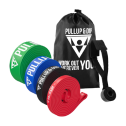
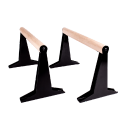
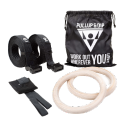

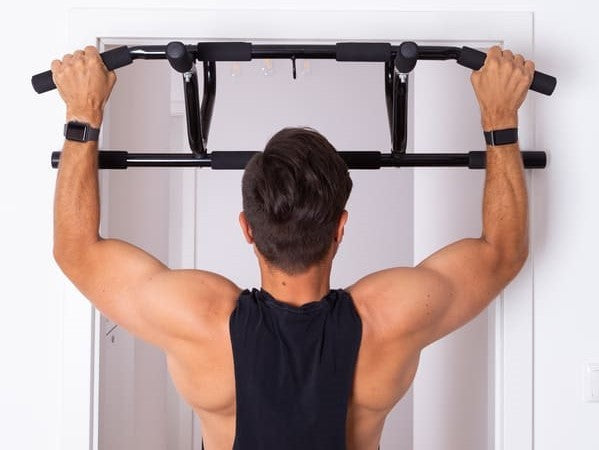
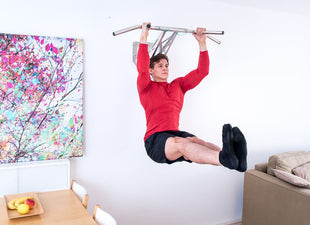
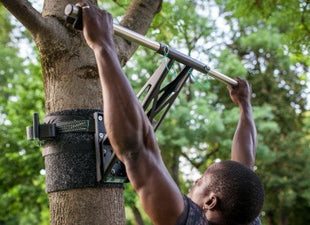
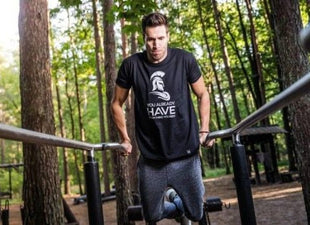
Leave a comment
All comments are moderated before being published.
This site is protected by hCaptcha and the hCaptcha Privacy Policy and Terms of Service apply.